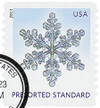
2013 10c Snowflakes: Narrow Tips
# 4810 - 2013 10c Snowflakes: Narrow Tips
$0.50 - $4.25
U.S. #4810
2013 10¢ Narrow Tips
Snowflakes
Snowflakes
Issue Date: October 1, 2013
City: Weston, Missouri
Quantity: 100 million
Printed By: CCL Label Inc., finished by Avery Dennison
Printing Method: Photogravure
Perforations: Serpentine Die Cut 11 Vertical
Color: multicolored
City: Weston, Missouri
Quantity: 100 million
Printed By: CCL Label Inc., finished by Avery Dennison
Printing Method: Photogravure
Perforations: Serpentine Die Cut 11 Vertical
Color: multicolored
The snowflake stamps were designed to be used by bulk mailers. The stamps picture five different photographs of snowflakes under strong magnification. The photographer also took the photos used for 2006 Holiday Snowflakes stamps. The stamp was available in coils of 3,000 and 10,000. The Snowflake stamps were the first to be printed by CCL Label Inc.
For the millions of people who look forward to the first snow every year, it can be a magical time. Watching as the tiny snow crystals fall from the sky, it’s hard not to catch them on a sleeve or mitten and marvel at the elaborate beauty. The lucky few will see one of the intricate, nearly symmetrical flakes that adorn winter decorations. But more often than not, they will see what scientists call irregular crystals, one of several different types.
Irregular crystals, the most common type, appear clumped together and bear little resemblance to the elegant flakes most of us picture when we think of a snowflake. Another common type is stellar plates. While they feature the six arms all snowflakes have, they are thin and broad, like a dinner plate. Sectored plates are similar, but the arms are narrow.
The most popular snowflakes are stellar dendrites. Dendrite means “tree-like,” so these flakes have branches. The flakes are usually two to four millimeters wide and can be seen with the naked eye. Fernlike stellar dendrites have even more side branches and are the largest snow crystals – usually five millimeters wide or larger.
The number of different kinds of flakes is a matter of debate even today. Scientists’ estimates range anywhere from seven to 80 types of snow crystals.
U.S. #4810
2013 10¢ Narrow Tips
Snowflakes
Snowflakes
Issue Date: October 1, 2013
City: Weston, Missouri
Quantity: 100 million
Printed By: CCL Label Inc., finished by Avery Dennison
Printing Method: Photogravure
Perforations: Serpentine Die Cut 11 Vertical
Color: multicolored
City: Weston, Missouri
Quantity: 100 million
Printed By: CCL Label Inc., finished by Avery Dennison
Printing Method: Photogravure
Perforations: Serpentine Die Cut 11 Vertical
Color: multicolored
The snowflake stamps were designed to be used by bulk mailers. The stamps picture five different photographs of snowflakes under strong magnification. The photographer also took the photos used for 2006 Holiday Snowflakes stamps. The stamp was available in coils of 3,000 and 10,000. The Snowflake stamps were the first to be printed by CCL Label Inc.
For the millions of people who look forward to the first snow every year, it can be a magical time. Watching as the tiny snow crystals fall from the sky, it’s hard not to catch them on a sleeve or mitten and marvel at the elaborate beauty. The lucky few will see one of the intricate, nearly symmetrical flakes that adorn winter decorations. But more often than not, they will see what scientists call irregular crystals, one of several different types.
Irregular crystals, the most common type, appear clumped together and bear little resemblance to the elegant flakes most of us picture when we think of a snowflake. Another common type is stellar plates. While they feature the six arms all snowflakes have, they are thin and broad, like a dinner plate. Sectored plates are similar, but the arms are narrow.
The most popular snowflakes are stellar dendrites. Dendrite means “tree-like,” so these flakes have branches. The flakes are usually two to four millimeters wide and can be seen with the naked eye. Fernlike stellar dendrites have even more side branches and are the largest snow crystals – usually five millimeters wide or larger.
The number of different kinds of flakes is a matter of debate even today. Scientists’ estimates range anywhere from seven to 80 types of snow crystals.










